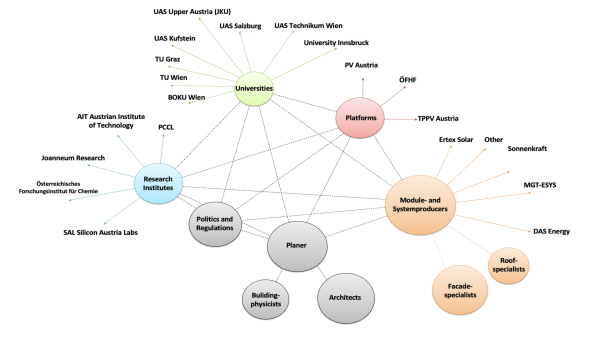IEA PVPS Task 15: Enabling Framework for the Acceleration of BIPV (Working period 2024 - 2027)
Short Description
The mission of the IEA PVPS program is to strengthen international cooperation in order to position photovoltaic solar energy as an essential part of renewable energy supply. Photovoltaics in general, and thus also the integration of photovoltaics into buildings (BIPV), represents an essential building block in the energy system of the future. The issues of land consumption for PV and dual use are now making BIPV increasingly important. Solutions for photovoltaics integrated into the building envelope are therefore increasingly becoming the focus of the construction industry.
As in previous project periods, the international network of experts will be used for national research and development in the field of BIPV. In the next phase (2024-2027), the following priorities will be addressed:
- Role of BIPV in a decarbonized circular economy and global society
- Framework conditions and social acceptance of BIPV
- Reliability and performance of BIPV systems (also in comparison to PV in ground-mounted systems or other applications)
- Identification of product characteristics and determination of optimization potential for specific areas of application (e.g. integration into infrastructure)
- Innovative/new BIPV technologies, modules, systems and applications / global screening
- Knowledge transfer; training measures and method development to involve all stakeholders
The national consortium focuses on the following activities:
- The potential and role of BIPV in a decarbonized circular economy and global society
- Framework conditions and acceptance of BIPV,
- Innovative/new BIPV technologies, modules, systems and applications
- Dissemination of the task in a target group-specific manner.
From the Austrian side, the topics of color design of BIPV modules are of great interest, as Austrian manufacturers produce modules with such properties or their components (e.g. colored embedding films from Lenzing Plastics, ceramic-printed front glasses in modules from Ertex and Sonnenkraft). The coloring influences the performance and its modeling (digital twin), but also on the test and approval procedures (e.g. EN 50583 Ed.2, ISO 15099).
Project Images
Terms of use: The pictures listed underneath the header “Project Pictures” originate from the projects in the frame of the programmes City of Tomorrow, Building of Tomorrow and the IEA Research Cooperation. They may be used credited for non-commercial purposes under the Creative Commons License Attribution-NonCommercial (CC BY-NC).
Participants
Australia, Austria, Canada, Denmark, France, Germany, Italy, Japan, Korea, Norway, Singapore, Spain, Sweden, Switzerland (lead), the Netherlands, China, Belgium and Israel
Contact Address
Project lead
FH-Prof. Ing. Momir Tabakovic PhD. MSc
University of Applied Sciences Technikum Wien
ENERGYbase, Giefinggasse 6, 1210 Wien
Tel.: +43 1 333 40 77 5815
Mobil: +43 664 889 609 68
E-Mail: momir.tabakovic@technikum-wien.at
www.technikum-wien.at
Project partners
Dr. Gabriele Eder
OFI
Franz -Grill-Straße 5, 1030 Wien
E-Mail: Gabriele.Eder@ofi.at
DI Karl Berger
AIT
Giefinggasse 2, 1210 Wien
E-Mail: karl.berger@ait.ac.at
Arch.in DIin Astrid Schneider
TU Wien
Research Project BIM4BIPV, Architektur E253-004
E-Mail: astrid.schneider@tuwien.ac.at

